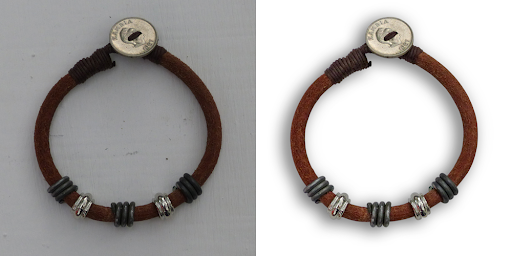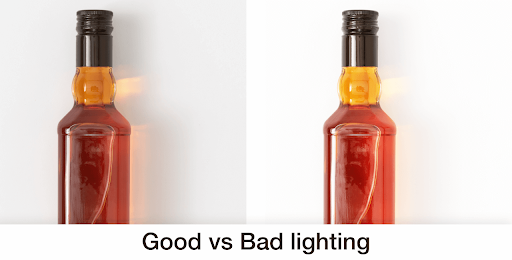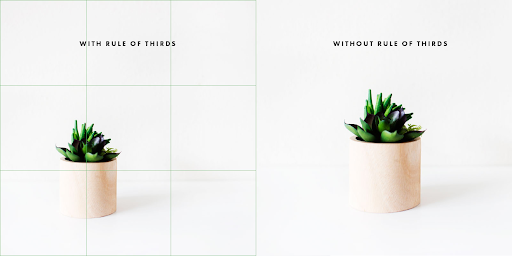What Is Product Photography?
Product photography, or commercial photography, is an image of a product or good for sale. When it comes to e-commerce stores having great product photography is key since this will be the first impression shoppers have of your product.
In fact, 50% of online shoppers say, "large, high-quality product images are more important than product information, descriptions, or even reviews." Great product photography allows you to showcase your product in the best possible light and entices shoppers to purchase it.
It's easy to make some mistakes when first starting out with your online store, and these mistakes can cost you revenue. That’s why in this blog we’re going to be covering the common mistakes eCommerce stores make and how to avoid them.
Mistake #1: Overexposure or Under-Exposure
Wondering why your product picture looks too dark or too light? This has to do with the exposure settings. Exposure is a measurement of how much light reaches the film or camera sensor when a picture is taken.
If a picture is overexposed it means that it’s too light. There’s too much light hitting the sensor in the digital camera, there’s little detail, and it appears washed out.
If it’s underexposed there’s not enough light hitting the camera’s sensors. It’s very dark, hard to see details, and there are few tones throughout the photo.

Source: Digi5Studios
You want your product image to strike a balance between these two, meaning it has a mix of shadows and highlights. To do this you’ll need to go into your camera settings and make some adjustments to things like shutter speed, aperture, and ISO to find out what works best.
Mistake #2: Poor Lighting
The best camera in the world won’t do much for you if you have bad lighting. That’s why it’s important that you take the time to learn how to properly light your product photos.
For light sources, you can use studio light or natural light, but something to take into consideration is the placement of the light and how this will impact the product’s appearance.

Source: Appypie
22% of returns happen because a product looks different in person than in photos so you want to make sure that customers are getting an accurate picture of the product.
Mistake #3: Not Enough Pictures
Do you only have one picture of your product? If so, you have a big problem. You should have at a minimum of 3 photos, although you really can’t go wrong with more. A study that analyzed the top 25 fashion and apparel brands found that on average, there are approximately 8 photos on the product pages for clothing items.
And online shoppers want to see products from all angles before making a purchase. In fact, in a study conducted by Bigcommerce and Square, the second most hated thing about online shopping is not being able to feel, touch, or try the products they’re buying.

Source: Neil Patel
To make up for not physically seeing the product and to build customers trust, you need to show the product in detail. This means close-ups, different angles, and possibly for items like clothing, the product on a model.
Mistake #4: Distractions
In product photography, the focus of the picture should be your product. This means you need the proper background. Usually, simple is better meaning you can’t go wrong with a plain white background.
“White and neutrals tend to work best for the majority of products, allowing the product to pop. These backgrounds also best showcase the detail of the product” - Andrew Leibowitz, VP, Client Services at Astound Commerce

In the above example, you can see there are a lot of elements behind the dress - a brick wall, a mirror, and more. The eye doesn’t know where to look and this takes the focus away from the dress. This picture would have benefited by reducing the clutter in the background and instead opting for a neutral background that allows the dress to be the star of the show.
If you find a white background too boring some other great backdrops are fabric, rugs, marble, or wood. For jewelry photography, the bokeh technique is popular where you leave part of the frame out of focus, and instead, draw the eye to the foreground.
Want to use props? Just make sure they help the product stand out rather than detract from it.
Mistake #5: Not Using A Tripod
Have you ever tried holding a camera completely still? It's really difficult and often pictures come out a little blurry. A tripod provides more stability to a camera and gives you the ability to frame and adjust shots in order to create a great composition. When shooting on slow shutter speeds a tripod becomes even more important.

You can get a decent tripod for as low as $30, and it can last you for years. If you don’t want to buy one just yet you can also stack items like books and place the camera on top. This trick allows you to capture a stable shot, although you’ll be able to make fewer small adjustments.
Mistake #6: Using Weird Product Angles
It’s okay to want to get creative with your product photography, but you might not want to get so creative customers can no longer see the product.
It may be boring, but you honestly can’t go wrong with a front-angle shot. This is the most used shot by eCommerce stores for a reason. This shot brings about a feeling of familiarity and confidence because it’s reminiscent of walking into a store and seeing a product, and also shows the product's key features.
Don’t want the product to be directly in the middle of the shot? Keep in mind the rule of thirds. This is a composition guideline that places your product in the left or right third of an image, leaving the other two thirds more open.

Source: Pinkpot Studio
Mistake #7: Going Overboard with Photoshop
Editing your product images is an important step in product photography. It allows you to get rid of small blemishes, lighten up photos, or even remove backgrounds. The issue that comes up is when you poorly edit an image or edit way too much of it.
In both of these instances, the customer can instantly spot the editing and it distracts them from the product. It can also deter them from buying a product since they feel they can longer trust the authenticity.
Conclusion
It can definitely be difficult to nail your product photography but by avoiding these product photography mistakes you'll be providing a great customer experience and showcasing your products in the best light. As they say, a picture is worth a thousand words and potential buyers want to see high-quality images before making a purchase to ensure they’re getting the product they actually want.
By focusing on these photopgrahy fundamentals you’ll be positioning you ecommerce store in the best light and providing the best online shopping experience possible.
